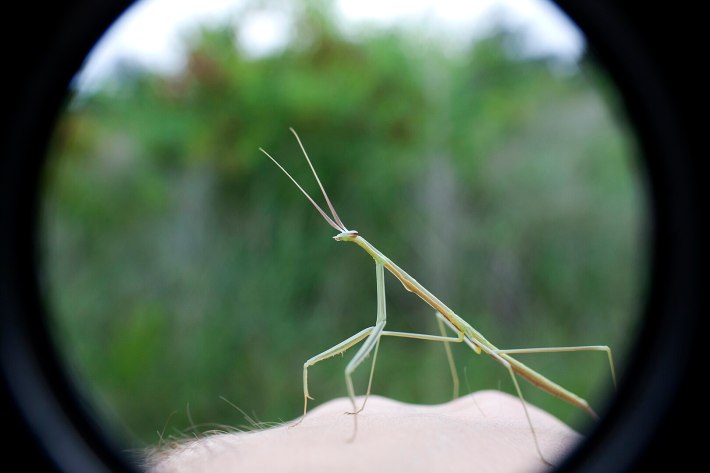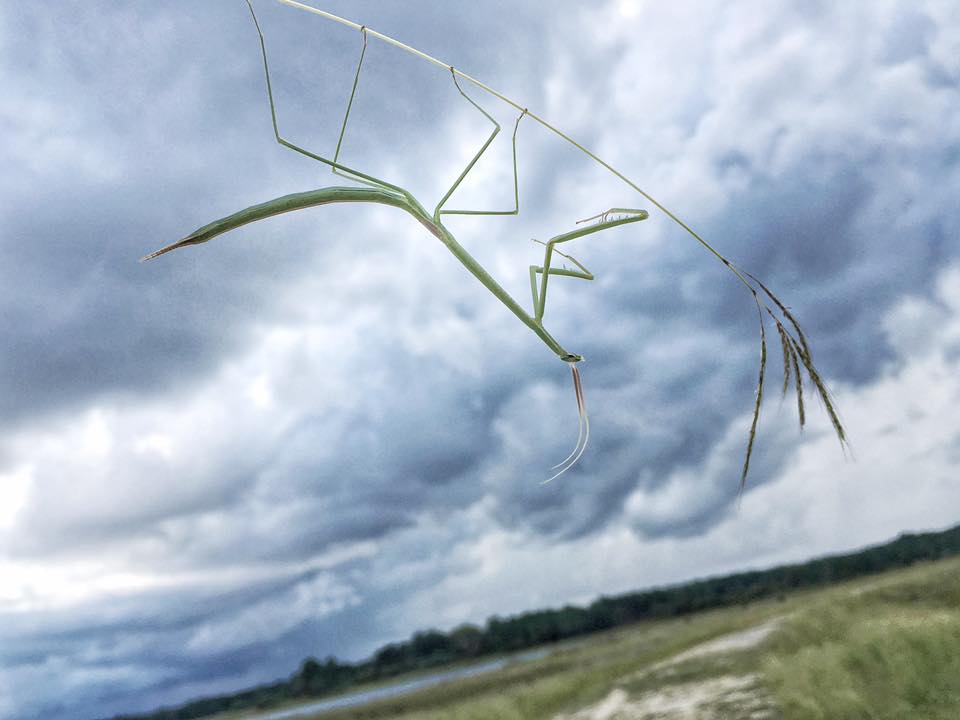With a slender green body reminiscent of a blade of grass and wings so puny that it cannot fly, the northern grass mantis Brunneria borealis could almost pass as a stick insect. The species lives along a 1,700-mile scythe of land across the Southeast and the Gulf Coast, from the Atlantic Ocean to Texas. While the mantis might not catch the eye of the average person, it is famous among entomologists for being exclusively parthenogenetic. Every B. borealis is a female, capable of laying eggs without the participation or even presence of a male.
A mother mantis will lay a clutch of eggs that will erupt with nymphs, which molt into adult females capable of laying their own eggs, and so on. Of all the more than 2,400 known species of mantids in the world, B. borealis is unique—the only one to reproduce exclusively through parthenogenesis.
This singular status intrigued Larry Hurd, an ecologist at Washington & Lee University in Lexington, Virginia. "I am amazed that nobody seems to have been working on this species, since it keeps being mentioned as the world’s only obligate parthenogenic praying mantis," Hurd wrote in an email. The only prior study of B. borealis Hurd could track down was a paper from 1948, published by the zoologist Michael J. D. White. White's paper seems to be the first to have declared B. borealis as exclusively parthenogenetic, but noted that the genus Brunneria appeared to live all over South America, with species recorded in Patagonia, Uruguay, Paraguay, Bolivia, and Brazil. Moreover, "the South American species, however, are bisexual, males being apparently as common as females," White wrote.
This paradox puzzled Hurd. Here was a tiny species of insect that, despite not being able to fly, had become incredibly geographically widespread and abundant across the United States, despite having many close relatives in South America. And unlike all other species of praying mantis, B. borealis was exclusively parthenogenetic, a reproductive strategy that is eventually self-destructive, leading to low genetic diversity. He wondered: What was the deal with this little wingless mantis? In a new paper published in the Annals of the Entomological Society of America, Hurd and colleagues offer a new origin story for B. borealis. They suggest the entire population, which is to say the entire species, may stem from a single female mantis arriving in North America. In other words, she is mother (and so are all her daughters).

Hurd and Greg Cooper, a researcher at Washington and Lee University and another author on the paper, went on two road trips to collect the grass mantids in their habitat. They "went through all coastal states from eastern Texas to North Carolina over the period of one week each trip," Hurd said. "A lot of driving!" B. borealis typically live in grassy fields, and the researchers could often capture a dozen of the mantids in less than half an hour using a sweep net. They brought the insects back to the lab and preserved them, marking which individuals came from which sampling locations.
The researchers then extracted sequences of the mitochondrial COI gene from 24 samples across seven states. "Mitochondrial DNA is not generally under selection the way nuclear DNA is," Hurd said, adding that mitochondria have different DNA than their host cells. "Mutations are not weeded out but can tend to accumulate." This makes mitochondrial DNA a good indicator of how long a species has been separate from its relatives. But the researchers detected no variation in the mitochondrial COI gene, indicating that B. borealis must have come to North America quite recently. "Finding a species distributed so widely in geography with absolutely no variation is extremely unlikely, if not unique," Hurd said. The lack of any differences makes it impossible for the researchers to pinpoint when, exactly, the mantid came to North America, except that the insects certainly arrived before the 1940s when people began discovering them in the South, Hurd said.
How did a small flightless insect travel from South America to Texas? The researchers suspect the mantid stowed away in a boat, and White's 1948 paper suggested the bug may have been transported by sea or a hurricane. But Hurd has a hypothesis answering the more interesting question—how B. borealis became the only parthenogenetic mantis in the world. While working on a future paper on these mantids, Hurd began corresponding with Mariana Trillo, a researcher at the Clemente Estable Biological Research Institute in Uruguay, who sampled B. subaptera, a species that is nearly physically indistinguishable from B. borealis. B. subaptera has both females and males but appears to have the option to reproduce parthenogenetically. Trillo "found some field habitats in which there were no males, and females were laying eggs that hatched in the same way our species does," Hurd said. So even though these B. subaptera mantids could reproduce sexually, in a location with no males the females had become functionally exclusively parthenogenetic.
"So, the simplest—hypothetical—origin story of B. borealis is that a single unmated, facultative parthenogenic, female made it across the Gulf of Mexico" and no males came along for the ride, Hurd said. "Presto: she’s an obligate parthenogen." He finds this hypothesis far more likely than the possibility that B. borealis lost its ability to reproduce sexually in the tropics of South America before migrating to North America as a brand-new species. So if you ever encounter a remarkably stick-like praying mantis in the South, salute her and her many, many clones. She is descended from a very powerful single mother and she is here to stay.







